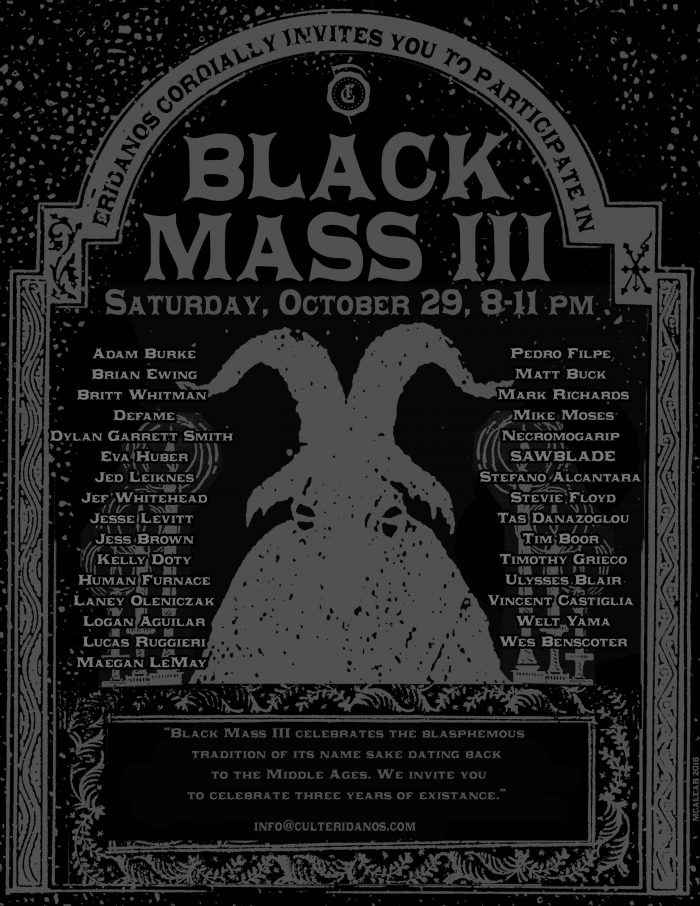The Black Mass is one of the greatest expressions of dark art known to man. It is theater on a grand scale in which the participants outwardly reject societal and religious norms in favor of rebellion, independence and blasphemy. Each participant, at some level, has had to mentally and psychically unshackle themselves from years of social conditioning to stand alone in defiance of accepted universal order as part of the Dark Lord’s heretical celebration. This coming Saturday in Cambridge, Massachusettes, Eridanos Tattoo & Gallery will be drawing upon the infamous Messe Noire as inspiration for their third anniversary celebration to highlight the dark artistry upon which they have built their existence. Dubbed Black Mass III, celebrations will include a performance art piece as well as an art exhibit centering around the infamous ritual. According to Eridanos:
Black Mass is a ceremony characterized by obscene and blasphemous rituals. The term “Black Mass” continues to be analogous with its rich history of sacrilege against the Catholic Church and a condemnation of morality. The artists come from eclectic backgrounds of illustration, metal and tattooing communities to create their own renditions of what horrors encompass their own Black Mass.
The show will feature a slew of heavy-hitters from the dark art world, including Jef Whitehead, Stevie Floyd, Tas Danazoglou, Adam Burke, Lucas Ruggieri, and many other incredibly talented artists.
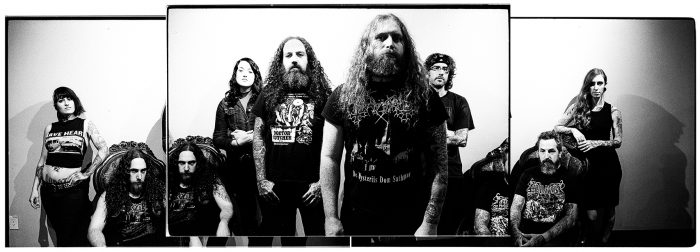
I interviewed Eridanos owner and Black Mass III mastermind Mark Blanchard about the event, dark art and whether or not he has any concerns about holding the celebration in a community that only a few years ago found priests and locals up in arms about a proposed Black Mass a mere mile down the road at Harvard.
First, tell me a little bit about the history of Eridanos.
In 2012, I was living in New York working at Last Rites. I stuck with what I knew: a business model that featured a tattoo studio and a gallery all in one space. I brought that model to Boston, and honestly, nothing has really changed – just the location.
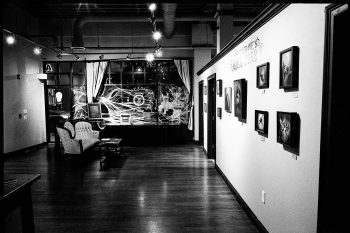
What was the impetus behind Black Mass III?
Black Mass is what we call our anniversary show. It’s a way to gather our community and celebrate the dark art movement.
We don’t preach political or religious beliefs: we want to leave that decision up to the viewer.
You’ve amassed a pretty impressive list of artists from the tattooing, metal and dark art world for this show, how did that all come together?
We have worked with a lot of these artists either in our shop, tattoo conventions or at other galleries and are united by our similar aesthetic.
A lot of the shows that we do are very similar in subject matter and also we show with them at other galleries. It’s a dark art community and there’s a very large camaraderie with dark artists nationally and internationally.
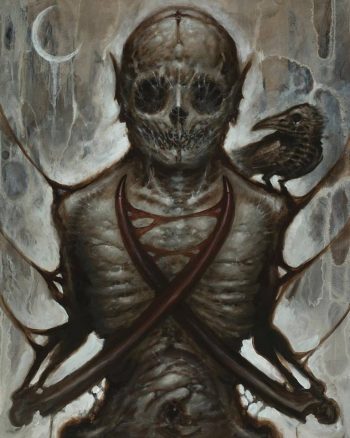
Speaking of community, it seems that it is easier today through the internet for dark artists to connect, collaborate and simply get to know each other. As a result, I feel like we are at a point where it’s safe to say there is a movement surrounding dark art based in the occult, heavy metal, punk and dark wave music, albeit one without any necessarily overarching ethos, other than maybe do what you will, and live authentically – both traditional hallmarks of punk and metal culture. It seems to be a movement more bound by an interest in primal and macabre subject matter – such as the occult, death, dark and sometimes deviant sexuality – as well and other societal and religious taboos. What do you see as Eridanos’ role in dark art culture?
The internet is a means for a networking; in one way, it’s great for accessibility to all sorts of amazing work, and in another, it’s easier for art and culture to be bastardized. Like anything, the internet allows trends to come and go really fast and keep up with relevancy. It’s great to stay up to date on what everyone is doing, but when it comes to the art, it doesn’t really capture the essence of the piece.
It is one thing to see the art in person, and another to see a pixelated translation on the Internet. As a dark art gallery, you can physically see the quality of the paintings and the media used –tangibility. You connect with them differently than, say, you would a photo through a screen. It’s so easy to click “attending” or “interested” on the internet these days, but there’s a sort of intimacy in spending time with the artists and others who want to see the work up close.
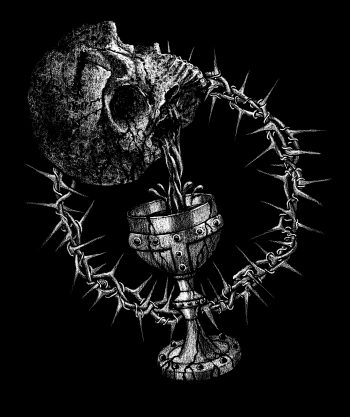
Part of the event is going to be a burlesque inspired by the Black Mass itself; can you tell me why you choose that particular rite and what it means to you both in personal and artistic terms?
Black Mass is a directive, we leave it open to artistic interpretation. This is the first time in our (short) history that we have had a performance art component to our anniversary show: just like every year, our business changes we want our anniversary to follow suit. Everyone’s piece, be it visual or performance, will be their own unique interpretation of what Black Mass means to them.
I was recently at The Satanic Temple in Salem, and when I asked if they had any negative reaction to their opening, they said that they really had none, attributing it to the fact that in Salem people are extra careful not to repeat the history of the town; but one of the employees there made the offhand comment that it seems like it’s impossible to shock people anymore. As someone who lives in the firmly conservative Christian Midwest, I wondered if that would be the case if The Satanic Temple opened up down the street from, say, Mike Pence’s house in Indiana. It seems like even a few miles down the road in Boston that attitudes may not be any more accepting. I seem to recall an attempted Black Mass at Harvard in 2014 that didn’t go over so well. What kind of response have you had, or do you anticipate, from this?

In response to the Black Mass 2014; Tim (the coordinator) does a lot for the community. It was not due to his lack of trying that this event wasn’t an overwhelming success – Harvard initially agreed to host it and then recanted its offer so he had to change the venue on the fly. The Satanic Temple (TST) is their own thing, we can’t really speak for their own objectives but it definitely wants people to question how people think about Satanism and the fixtures of socially acceptable thought.
Boston is a Puritan town; there is a history of people stepping in and throwing two cents into what anyone is doing, if it’s progressive or not, or adhering to their guidelines. Salem is all about being spooky: it’s what makes up a majority of their local economy, so it makes sense that TST didn’t upset too many people, and why the Black Mass at Harvard ultimately had a lot of backlash.
Last year a handful of people who identified as Christian gave us their two cents about the artwork in Black Mass II: but honestly I think a lot of it had to do with the fact there was a Christian convention in town for a long weekend. Since we are a conceptual art gallery we can get away with a lot more creative expression than say, a political group such as TST.
The only attendees we want are the ones who want to see the art: we aren’t playing devils advocate over here. This is our own objectives we can’t really speak for others. This is a conceptual Black Mass: open to interpretation by artist and viewer. If people want to come, great. If it’s too edgy for some, that’s fine, but we aren’t looking to impress them, they can do a variety of other things that evening.
 If someone does choose to come out that evening, tell us what they can expect.
If someone does choose to come out that evening, tell us what they can expect.
This night is about celebrating art and seeing dark art in person. In short: a serious international collection of dark art and artists in one room, libations, burlesque, costumes and a little blood.
What would you like to see for the future of Eridanos as a gallery?
We will continue our monthly momentum, extending our reach outside of New England and New York to some sights out west. Every show we strive for a higher level of achievement, and that won’t change. Stay tuned to see what we have planned for 2017.
Eridanos is located at 36 Prospect St, Cambridge, Massachusetts. Event info HERE.

